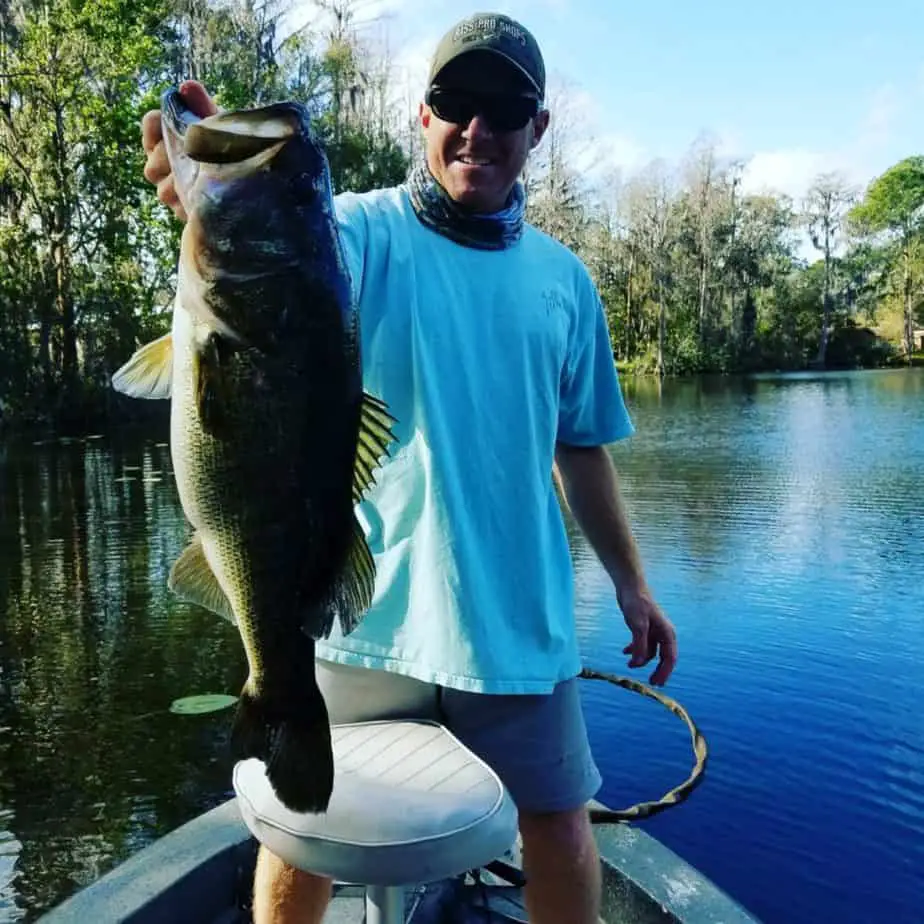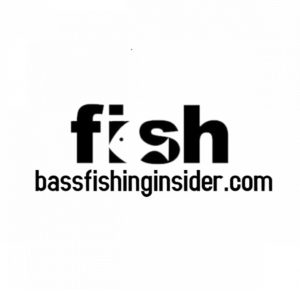
My biggest bass to date is a 13-pound lunker caught out of a Florida lake. I’ve been lucky and blessed to catch quite a few monster bass, including a large number of 6 and 7-pounders, as well as numerous trophy catch-size bass (over 8 pounds).
I’ve noticed that bigger bass tend to come from areas that share similar characteristics. I’ve also spoken to a number of tournament anglers, guides, and anglers and have done a ton of research to uncover the best areas to catch lunkers.
For a unique insight into how to find the biggest bass in a lake, check out the following 15 high-percentage spots to catch lunker bass.
1. Fish the Bank for Big Bass, Especially Near a Steep Depth Change
Most of my personal big bass catches have come from shoreline cover near deep water. I’ve found that shallow water near an abrupt change in depth tends to hold big fish. Once you’ve identified these areas, look for cover (timber, vegetation, docks, etc.) that provides shade and ambush points for giants.
2. Fish Deep into Cover for Big Bass. 3 Examples.
Big bass tend to live longest in places where most people don’t fish. After all, they’ve survived longer than the rest of the population in a lake because they have adapted and found ways to outlast others.
As an angler, you’ll need to be able to reach places that most anglers would not dare to cast for fear of getting stuck or not being able to get a fish out once hooked.
- Trees that overhang a bank can hold some big fish, but many fishermen can’t find a way to get a lure back far enough under the trees to reach bass waiting for prey to fall off the bank. Try skipping jigs or soft plastics back to waiting fish to reach bass in these situations.
- Bushes can be big bass sanctuaries. However, many people can’t seem to find a way to fish for bass buried in the thick stuff. Instead, astute anglers switch to a punch rig with a smaller creature bait that will penetrate the cover. Once they hook a bass, they understand that they may have to get dirty and reach down into the bush to retrieve their catch.
- Big bass love to hide in big weed or reed clumps that may appear overwhelming to many people. Experienced anglers opt for a bigger rod with a heavier braided line and a smaller profile soft plastic to reach bass in deep cover. Once again, they know they may have to reach in and get a little wet to haul the bass out once hooked. Here’s a great article on how to fish for bass in the reeds.
In sum, you must be willing to make presentations where no one else would dare to fish. Try spots that receive the least fishing pressure possible.
3. Fish Docks For Trophy Catch Bass
Docks are a favorite of many professional tournament anglers and for a good reason. Watch any pro tournament on television, and you’ll see at least one pro focusing on docks as their primary target.
Many fishermen know that docks hold fish year-round. Once again, you’ll need to fish parts of the dock that no one else will. Learning to skip a jig to the farthest reaches of the dock can pay off hugely for big fish.
My two sons (high school anglers) recently spent an entire tournament day fishing docks for bass and did well because they were able to reach parts of the dock that most anglers could not as a result of their hours of practice skipping baits to remote dock areas.
4. Fish the “Secret” Stash. Community Holes Can Hold Big Bass.
When fishing a deepwater community hole with underwater cover like brush piles, it’s common to approach the spot first and check it out with your fishfinder to scan for signs of fish life. Unfortunately, many people steer away from community holes when they don’t find any initial evidence of bass.
However, moving on from a brush pile that appears empty may be a mistake. Big bass often hold so tight to cover that they don’t show on sonar. Take a minute to drop a line on deepwater cover that appears vacant. You might be surprised at what’s waiting below!
5. Find the Big Ones in Log Laydowns
Log laydowns are excellent spots to find lunker bass. Laydowns often serve as a home for big resident fish, using them as perfect ambush points.
6. Fish Current Breaks for Bigger Bass
It is widely accepted that bass love current. Big bass use breaks in the current as spots to lie in wait to ambush prey. The following objects can create perfect current breaks that deserve special attention:
- Logs
- Bushes
- Large Rocks
- Pilings
7. Look for Hard Ground During the Spawn for Giant Bass
The spawn is a special time of year when big bass move into spawning grounds to make beds. Spawning grounds almost always have one thing in common: hard ground. Identify wind-protected areas of your lake that include a bottom composed of hard ground, and you’re on your way to finding big spawning bass.
8. Try Isolated Offshore Grass to Locate Big Bass
I’ve gone out many times and loaded the boat fishing for bass in big areas of offshore grass. The trick to catching bigger bass in offshore grass is to locate isolated smaller areas that are separate from the bigger masses. The Harris Chain and Lake Toho in Florida are two prime examples of lakes known for offshore bass fishing. Buddy Gross used this strategy to secure a major FLW win on Toho. Check it out below.
9. Find Spawning Flats Near Deep Water for “Big ‘Uns” (Bass)
Many people believe that most big fish in a lake reside in deeper water. However, there is one obvious time of year when that changes: the spawn. Find spawning flats that are close to deep water, and you’re chances of landing a lunker go through the roof. Brush up on your sight fishing skills and get ready for a “big un”!
10. Big Mama Bass Live in Creeks and Canals During the Spawn
Once again, the spawn deserves special mention for big bass fishing. Bass move into protected areas to make beds when the time is right. Some of the most protected spots in a fishery are located in canals and creeks. Try quietly cruising the banks of canals and creeks in search of big bass holding tight to beds.
11. Offshore Structure and Cover = Gold
If you are an offshore fisherman, you know that finding offshore structure that INCLUDES good cover can be absolute gold when bass fishing for the biggest bass in the lake.
When checking offshore structure with your fishfinder, look for identifiable cover that is also present. Things like brush piles, submerged timber, and other things that sit on offshore structures are ideal big bass habitats. Check out Do Bass Like Shallow or Deep Water for more info on how to locate the best spots.
12. Isolated Cover Can Pay Off In Big Ways for Big Bass
Fishing cover that you can see on top of the water can be an overwhelming and daunting task at first glance.
To find the best spots, start with any isolated cover first. The following are perfect examples of places to check:
- Small groups of lily pads or single pads that stand apart from the rest of the field.
- A stand-alone log that doesn’t seem to belong.
- Small clumps of floating hyacinths.
- A reed patch that is removed from the rest of a reed line.
13. Target Subtle Variations in Surface Cover to Find Bass Fast
It’s commonly accepted that bass LOVE cover, but once again, where do you start?
I like to look for any slight, subtle variation in the landscape of the cover I’m fishing. Fish like anything that looks different. Below are a few examples:
- A small point made out of reeds in a long reedline.
- A small miniature cove in a lily pad field.
- Boat lanes in Kissimmee grass.
- A cut through a mass of hydrilla made by a boat or wind.
- A rockpile set apart from a long jetty or bank.
14. Fish the Mouths of Creeks and Canals in the Pre-Spawn
My son and I decided to ditch our bass boat and take the Jon boat to a small lake here in Florida about a year ago. (P.S. I love small boats and small lake fishing!) We started at the mouth of a canal, and for good reason. The canal was the most obvious spot in the entire lake for spawning, and we were in that season.
What transpired at that mouth was truly amazing.
We caught big fish after big fish while sitting in the same spot, anchoring in a tiny Jon boat to hold us in place. We caught several 3-pounders, a 5, and a 6, and my son had a GIANT up to the boat (maybe 8 to 10 pounds) that broke him off because he had decided to drop shot for fun and had hooked her on very light line.
The point is this. Focus on areas where big bass have reasons to travel. Creek and canal mouths are great spots to settle in and wait for bass to move in and out of spawning grounds.
15. Follow Transition Routes to Locate Big Pre and Post Spawn Bass
Once again, careful thought should be given to how bass move from spawning ground to deep water. Bass tend to follow specific patterns in movement. Check out the following kinds of underwater structures that serve as travel routes for pre and post-spawn bass:
- Creekbeds
- Underwater ditches
- Submerged, old roads
- Mid-depth range grass lines
The Bass Line. Final Word.
If you’re trying to find where the big bass hide, employ the tips and suggestions above to increase your odds of locating bigger bass. Your chances of catching a lunker will increase if you intentionally TARGET the right areas.
Time to get out to the water and land your new personal best!
Fish on!




